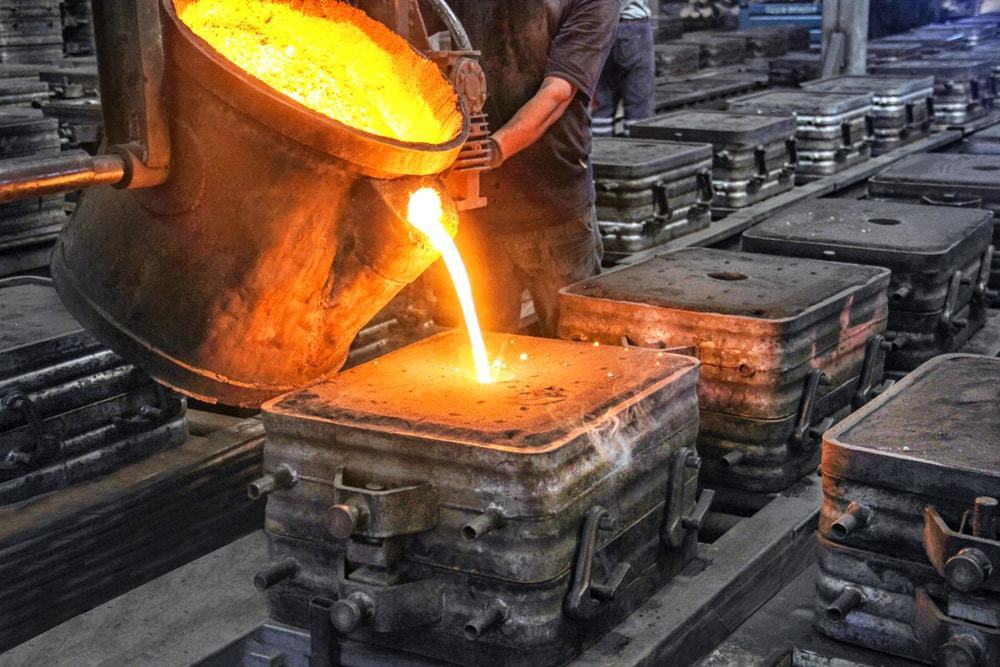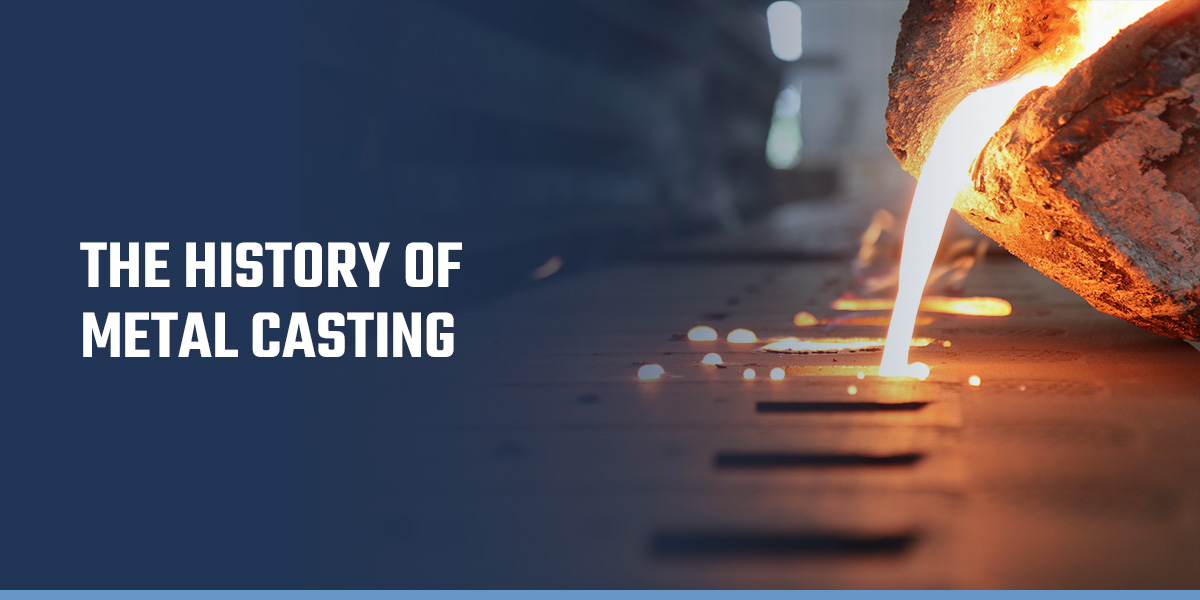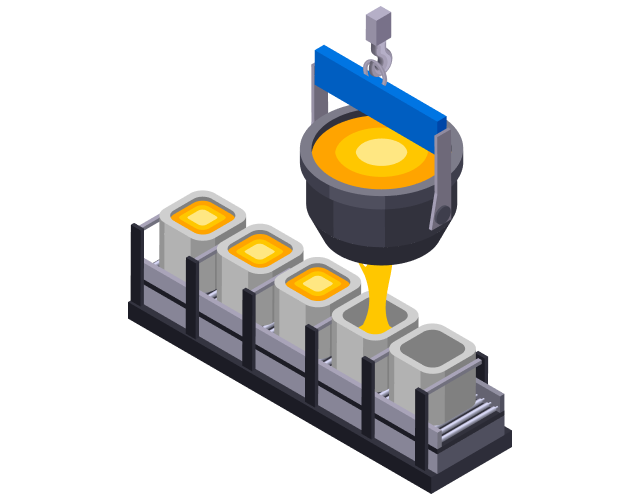Understanding the craftsmanship behind Wisconsin Aluminum Foundry and its success in casting excellence
Recognizing the Metal Castings Process: A Comprehensive Overview for Beginners
The Metal Casting process is a fundamental strategy in making that changes molten metal into solid forms. Newbies have to comprehend the different methods involved, such as sand casting and die spreading. Understanding the products, design principles, and precaution is equally vital. Each aspect plays a critical function in achieving effective results. As one browses these complexities, the inquiry of exactly how to maximize each step for improved results ends up being progressively important.
The Basics of Metal Casting
Metal Casting has advanced over centuries, its essential concepts continue to be essential and constant to the production procedure. At its core, Metal Casting involves the change of molten metal into strong things with different methods. The process begins with the creation of a mold and mildew, which specifies the shape of the final product. When the mold is prepared, steel is warmed to its melting point and put into the dental caries. After cooling, the metal strengthens, taking the shape of the mold and mildew.
There are numerous casting methods, including sand casting, financial investment casting, and pass away spreading, each with one-of-a-kind benefits and applications. The choice of strategy relies on factors such as production quantity, material kind, and wanted accuracy. As soon as cast, the end product may undergo additional procedures like machining or surface area therapy to attain the called for surface and specifications. Comprehending these fundamentals is necessary for any person interested in the area of Metal Casting.

Understanding Products Used in Metal Casting
Materials play a vital duty in the Metal Casting process, affecting the end product's properties and performance. Different steels are utilized, including light weight aluminum, steel, bronze, and iron, each offering distinct qualities matched for particular applications. Light weight aluminum is corrosion-resistant and light-weight, making it ideal for automobile components. Iron, particularly cast iron, is favored for its excellent wear resistance and resilience. Steel offers high toughness and flexibility, commonly utilized in hefty equipment elements. Bronze, recognized for its deterioration resistance and machinability, is typically used in marine applications.
In addition to the steels, numerous casting products, such as sand, plaster, and ceramic, are used to develop mold and mildews. Sand casting, one of the most prevalent approach, uses silica sand as a result of its thermal security and ability to develop elaborate shapes. Plaster and ceramic molds supply finer details but might require more complex procedures. The choice of materials straight influences the performance, cost, and high quality of the casting operation.
The Layout Refine: From Principle to Plan
The layout process in Metal Casting begins with the preliminary idea advancement, where concepts are created and assessed. This is complied with by the application of CAD modeling strategies, enabling for accurate visualizations of the layout. The plan completion actions assure that all requirements are properly documented for production.
First Idea Growth
First idea growth marks a vital phase in the Metal Casting procedure, where ideas transform right into substantial designs. Throughout this phase, developers work together with stakeholders and engineers to brainstorm and refine initial principles. They consider variables such as capability, looks, and manufacturability, making sure that the design fulfills the required requirements and performance requirements. Illustrations and outlines are developed to picture the concepts, enabling initial assessments of usefulness and cost-effectiveness. This phase additionally includes identifying products and potential spreading methods that line up with the layout goals. Eventually, first concept advancement lays the foundation for a thorough plan, leading the succeeding stages of the spreading process and guaranteeing a successful shift from idea to fact.
CAD Modeling Techniques
Transforming concepts right into specific styles, CAD modeling techniques play a critical function in the Metal Casting procedure. These strategies utilize advanced software application to develop in-depth three-dimensional models that precisely mirror the designated item. By employing devices such as parametric modeling, strong modeling, and surface area modeling, developers can adjust measurements and forms easily. CAD systems additionally promote simulation and evaluation, allowing for the recognition of potential defects prior to manufacturing starts. This aggressive strategy lowers product waste and optimizes the design for manufacturability. Additionally, CAD models can be conveniently customized, enabling fast versions based on responses. Fundamentally, CAD modeling serves as the backbone of the design process, connecting the gap between initial ideas and the eventual production-ready styles.
Blueprint Completion Tips
Complying with the creation of in-depth CAD models, the next phase entails plan finalization, which is critical in converting electronic styles right into actionable prepare for manufacturing. This procedure starts with examining the CAD models for precision and conformity with specifications. Once verified, the measurements, resistances, and product requirements are thoroughly outlined to guarantee quality. Integrating comments and notes assists communicate important details pertaining to casting processes, surface area finishes, and setting up demands. The wrapped up plan goes through an extensive approval procedure, usually including partnership with engineers and manufacturing groups to attend to any possible problems. Revisions are made and approvals acquired, the plan is formally released, offering as the foundational paper for the succeeding phases of Metal Casting, including pattern production and mold design.
The Metal Casting Strategies Described

Metal Casting methods encompass a selection of techniques used to form molten metal into preferred types. These methods differ according to the kind of material, intricacy of the style, and production volume. Sand casting is among the most typical approaches, including the creation of a mold and mildew from sand to hold the molten metal. Financial investment spreading, or lost-wax casting, permits elaborate layouts by using a wax pattern that is thawed away. Die casting uses high-pressure shot Wisconsin Aluminum Foundry of liquified metal right into a mold, appropriate for automation. Other methods consist of long-term mold casting, which makes use of reusable mold and mildews, and centrifugal casting, where rotational pressures aid in filling up the mold and mildew. Each method has its applications and advantages, making it essential for suppliers to select the suitable technique based upon their particular demands and demands. Comprehending these techniques is vital for any individual associated with the Metal Casting process.
Ending Up Procedures: Enhancing Your Casted Product

Finishing procedures play an important duty in enhancing the quality and appearance of Metal Castings casted items. Different surface therapy techniques, such as sprucing up and finish, are utilized to improve durability and aesthetic appeals. Furthermore, quality examination techniques guarantee that the last product meets specified standards and performance requirements.
Surface Therapy Strategies
A range of surface area treatment strategies play a necessary function in boosting the high quality and longevity of casted products. These strategies include methods such as shot blasting, brightening, and covering. Shot blowing up efficiently gets rid of surface flaws, improving the visual and functional features of the casting. Sprucing up gives a smooth finish, which is particularly vital for decorative applications and elements needing marginal friction. Finishing techniques, such as electroplating or powder coating, offer additional defense against corrosion and wear, making sure resilience. Surface area treatments can enhance adhesion for succeeding processes, such as painting or bonding. By employing these approaches, suppliers can attain superior surface high quality, which is crucial for the performance and life-span of Metal Casting in various applications.
Quality Assessment Techniques
Reliable top quality examination methods are necessary for assuring the honesty and performance of casted products after the finishing processes. Various techniques are employed to evaluate the quality of Metal Casting, including visual assessment, dimensional checks, and non-destructive screening (NDT) Visual inspection allows for the recognition of surface defects, while dimensional checks assure that items satisfy specified tolerances. NDT methods, such as ultrasonic screening and radiographic examination, give deeper understandings right into interior integrity without damaging the castings. Additionally, mechanical testing, such as tensile and hardness examinations, examines product properties - Wisconsin Aluminum Foundry. By employing a combination of these methods, makers can improve product top quality and integrity, eventually leading to higher customer complete satisfaction and reduced manufacturing costs
Safety And Security Considerations in Metal Casting
While the Metal Casting process provides many benefits, it likewise presents a variety of security risks that need to be carefully taken care of. Workers in casting centers are exposed to heats, liquified metals, and dangerous materials, which can result in severe injuries if correct preventative measures are not taken. Individual safety devices (PPE) such as heat-resistant gloves, face shields, and safety clothes is essential to reduce threats.
In addition, the existence of fumes and dust necessitates correct ventilation systems to guarantee air top quality - Metal Castings. Regular training on safety and security protocols is essential for all staff members to identify potential dangers and react efficiently. Emergency procedures should be developed, including fire safety actions and emergency treatment browse around this site accessibility. Maintenance of equipment and appropriate handling of materials further add to a much safer working environment. By prioritizing these safety and security factors to consider, Metal Casting procedures can protect their workforce and maintain efficient production processes
Often Asked Concerns
What Are the Ecological Effects of Metal Casting?
Metal Casting can bring about environmental impacts such as air and water pollution, resource exhaustion, and energy consumption. In addition, incorrect waste management and emissions from shops contribute to eco-friendly disruptions and health and wellness risks for nearby communities.
How Do I Choose the Right Steel for Spreading?
To select the ideal metal for casting, one need to take into consideration aspects such as mechanical homes, corrosion resistance, thermal conductivity, and cost. Examining the designated application and environmental conditions is crucial for excellent selection.
What Are the Usual Issues in Metal Casting?
Common flaws in Metal Casting consist of porosity, shrinking, sand inclusion, and misruns. These problems usually occur from incorrect material selection, insufficient design, or problems in the spreading process, impacting the end product's top quality and performance.
How Can I Boost My Steel Casting Skills?
To improve Metal Casting abilities, one must practice consistently, research spreading methods, evaluate previous tasks for flaws, seek responses from knowledgeable wheels, and continuously try out different materials and techniques to improve efficiency and understanding.
What Is the Price of Starting a Metal Spreading Service?
Beginning a metal casting service commonly needs a first financial investment of $5,000 to $50,000, depending on devices, materials, and center prices. Aspects like area and range can greatly affect general start-up expenditures.
The Metal Casting procedure is a basic strategy in making that changes molten steel into solid forms. Newbies must grasp the different approaches entailed, such as sand casting and die casting. There are numerous casting methods, consisting of sand casting, investment spreading, and pass away casting, each with one-of-a-kind advantages and applications. Financial investment spreading, or lost-wax spreading, allows for elaborate styles by utilizing a wax pattern that is melted away. Various other techniques include irreversible mold and mildew casting, which utilizes multiple-use molds, and centrifugal spreading, where rotational pressures aid in filling the mold and mildew.